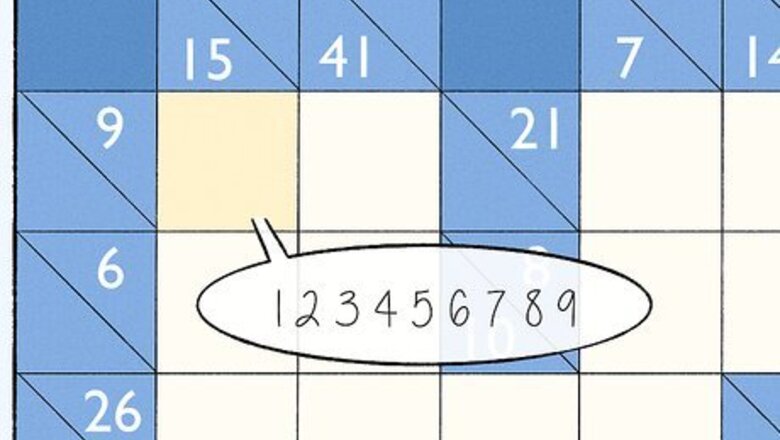
views
Learning the Basic Rules
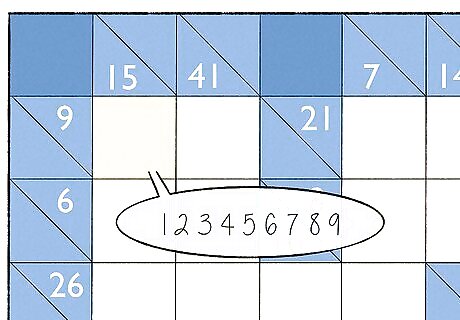
Enter numbers between 1 and 9 in the empty boxes or cells. Keep in mind that you cannot use zero in this game. Any number you enter into a single cell on the board must be a number between 1 and 9. There will be prefilled cells on every game board that already have numbers in them. These numbers are called “clues.” The game board will probably have prefilled numbers or “clues” that are over 9, but the player cannot use anything over 9.
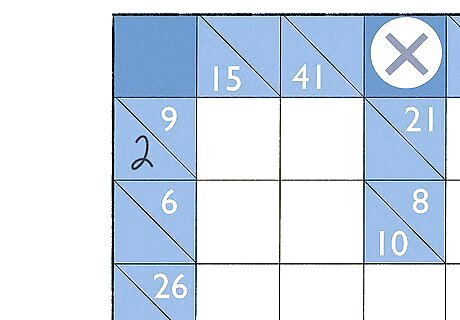
Do not write numbers in the shaded cells. The shaded boxes remain empty for the entire game. They break up the columns and rows into smaller “chunks” to create more space for gameplay on the board. The “clues” appear in the shaded boxes only. Any completely blank box is yours to work with. For example, 1 horizontal column might have a total 6 boxes. 3 of the boxes could be blank and 3 could be shaded. You can enter numbers in the blank boxes only. The shaded boxes break the column into separate chunks. Some shaded boxes have diagonal lines across the middle to create 2 triangles. A clue will appear in the top right triangle (above the diagonal line) or in the bottom left triangle (below the diagonal line). Horizontal clues always appear in the top right triangle. Vertical clues always appear in the bottom left triangle. Some bisected boxes will have a clue in the top and bottom boxes. This means the box is part of a horizontal and a vertical run simultaneously.
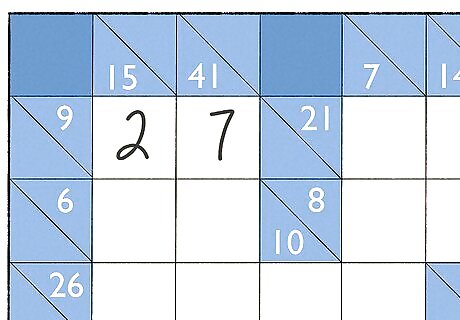
Enter 1-9 in blank boxes to make the horizontal block add up to the clue. Each cluster of squares follows this rule. The player’s goal is to fill in the blank horizontal boxes with numbers that add up to the provided “clue” at the far left of the horizontal column. For example, say the provided clue is 6 and you have 3 empty boxes on that horizontal cluster. You could use the following combinations since they all add up to 6: 1-2-3, 1-3-2, 2-3-1, 2-1-3, 3-1-2, or 3-2-1.

Input 1-9 so the sum of each vertical block equals the clue on top. The horizontal cells have to add up to a provided clue on the left, but simultaneously, the vertical blocks have to add up to their clue at the top. This is what makes the game so tricky! It’s a game of numerical balance. For example, say you have a horizontal row with 3 blank boxes and the clue is 22. The first blank box is also part of a vertical row of 2 blank boxes with a clue of 6. The first box in the horizontal row must also match up with that vertical row to equal a sum of 6. A solution for the horizontal row could be 5 + 8 + 9. Since the vertical row has 2 boxes and the clue is 6, 1 would be the answer to complete the vertical row since 5 + 1 = 6.
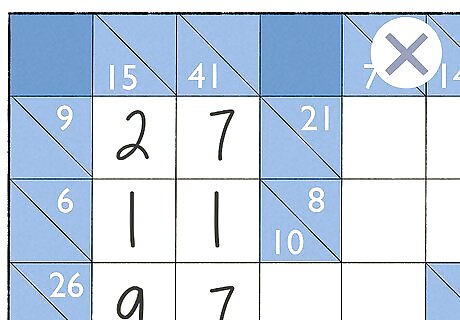
Do not repeat any numbers between 1 and 9 in a single sum group. For each horizontal (row) and vertical (column) sum group, you have to use any number that’s 1-9 but you can only use a particular number once. This is what makes the game even tougher! You can order strings of numbers any way that you’d like, though. For example, if the "clue" is 6 and you need to input 2 numbers, you can't use 3 + 3 since that would be repeating the number 3 in the same run. You can repeat the same number in the same row or column as long as there is at least 1 “clue” or shaded box between them.
Using Different Solving Strategies
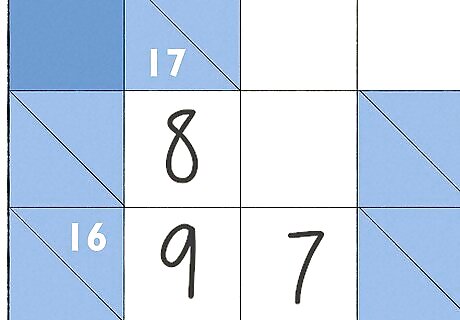
Start by filling in the common numbers. This is the easiest strategy for beginners to implement and it’s the perfect way to start a game. To demonstrate: If a row has a sum (or clue) of 16 over 2 blank squares and a column has a sum (or clue) of 17 over 2 blank squares, the only possible values are 7-9 for the row and 8-9 for the column. That means the common value for the intersecting box is 9. You would enter “9” in the blank box and move on to the next box to solve. Another example: Suppose a horizontal sum of 23 with 3 blank boxes intersects a vertical sum of 28 with 7 blank boxes. The horizontal row can only be 6 + 8 + 9. The vertical row can only be 1 + 2 + 3 + 4 + 5 + 6 + 7. The only digit in common is a 6, so that must be in the intersection.
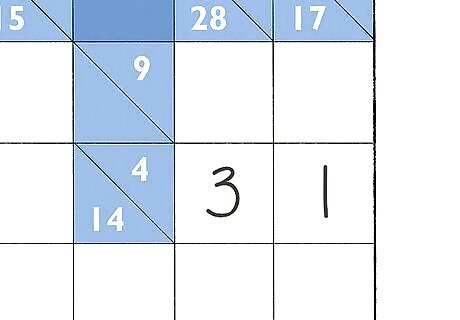
Look for clues that can only be solved 1 way and fill in those numbers. Some clues will always require the same number combination (although the order that the numbers appear can vary). Since these are always the same, memorizing them will definitely make solving puzzles a little easier for you. Some of the specific clues and their corresponding number combinations are: The sum 3 (across two cells) will always be 1 + 2 The sum 4 (across two cells) will always be 1 + 3 The sum 17 (across two cells) will always be 8 + 9 The sum 6 (across three cells) will always be 1 + 2 + 3 The sum 24 (across three cells) will always be 7 + 8 + 9
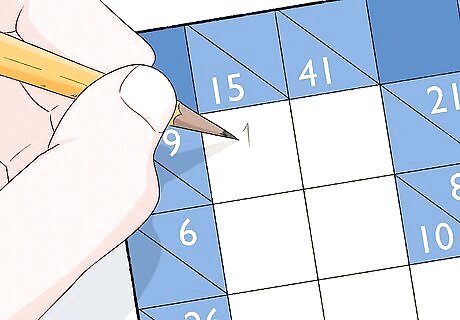
Use pencil marks to help you avoid mistakes and figure out solutions. Use a pencil to lightly write in the possible values for each clue in the blank boxes. As you keep working to figure out other clues, certain numbers will be eliminated from your pool of options. When that happens, erase that number. When you’re down to 1 digit left as a possible solution, you’ll know that’s the number you need to “officially” enter in the blank box.
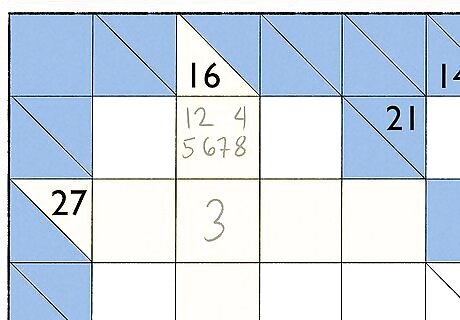
Compare restrictions for the crossing rows to make further deductions. If a specific number has already been used in a row or column, it cannot be used again in that same row or column. That means you can erase those lightly penciled in numbers for potential combinations. For example, if a horizontal clue of 27 with 4 boxes crosses a vertical clue of 16 (with all of the boxes filled) and the intersecting box contains a 3. You can erase any penciled-in combinations for the horizontal box that don't include a 3 since that digit is already in place.
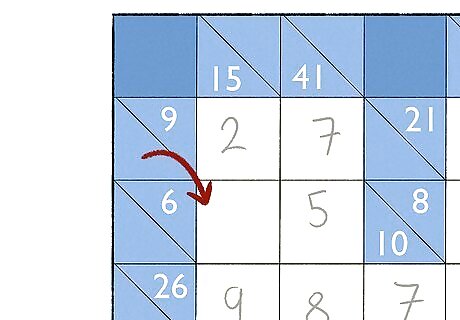
Look for boxes that only have 1 option left. Since numbers can only be used once in a row or column, you can figure out the remaining blank boxes pretty easily once you get to a certain point in the game. Many numbers will be disqualified as options at that point, leaving only 1 possible option for the blank box. Go ahead and fill those numbers in as you figure them out.
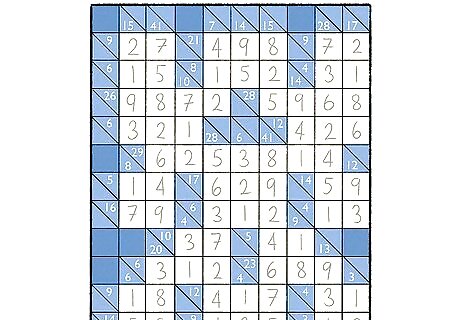
Continue reevaluating options using new information to solve the game. Every time you fill in a box, it will reveal certain options and limitations that help you further deduce your options. So, every time you enter a number into a blank box, reevaluate all of the remaining options for the boxes around it. Keep doing this until you solve the game by filling in all of the blank boxes! These puzzles will only have 1 correct way to solve them. There won’t be any variation in the number combinations. Basically, there’s only 1 correct and unique solution to every game.




















Comments
0 comment